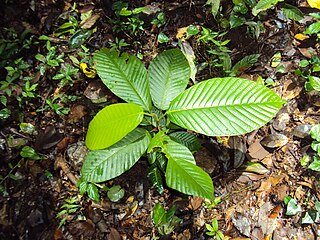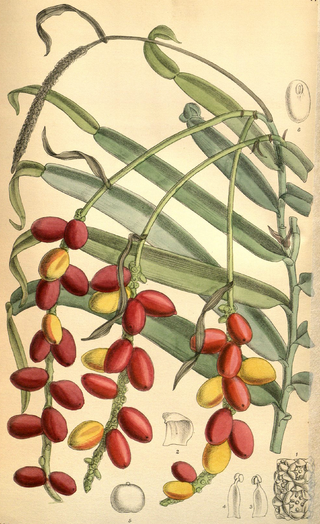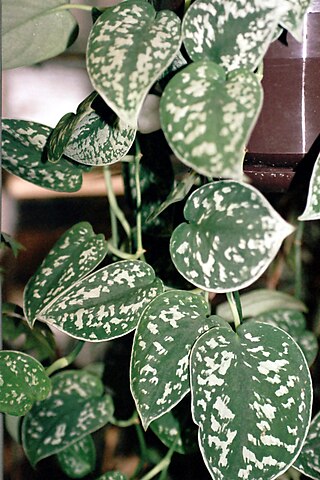
Cleistanthus is a plant genus of the family Phyllanthaceae, tribe Bridelieae, first described as a genus in 1848. It is widespread in much of the Old World Tropics in Asia, Africa, Australia, and various oceanic islands. Cleistanthus collinus is known for being toxic and may be the agent of homicides or suicides.

Kayea is a plant genus in the family Calophyllaceae. Its species range from Bangladesh and the eastern Himalayas to Sri Lanka, Indochina, Peninsular Malaysia, Borneo, Sumatra, the Philippines, New Guinea, and Queensland.

Dipterocarpus is a genus of flowering plants and the type genus of family Dipterocarpaceae.

Actinodaphne is an Asian genus of flowering plants in the laurel family (Lauraceae). It contains approximately 125 species of dioecious evergreen trees and shrubs.

Nepenthes × sharifah-hapsahii is a natural hybrid between N. gracilis and N. mirabilis. It has been recorded from Borneo, Peninsular Malaysia, Sumatra, and Thailand, although it was originally described as a species endemic to Peninsular Malaysia, where it was said to grow at elevations below 1000 m.

Pothos is a genus of flowering plants in the family Araceae. It is native to China, the Indian Subcontinent, Australia, New Guinea, Southeast Asia, and various islands of the Pacific and Indian Oceans.

Barringtonia is a genus of flowering plants in the family Lecythidaceae first described as a genus with this name in 1775. It is native to Africa, southern Asia, Australia, and various islands of the Pacific and Indian Oceans. The genus name commemorates Daines Barrington.

Pholidocarpus is a genus of flowering plants in the family Arecaceae, native to Southeast Asia.

Alseodaphne is a genus of plants in the family Lauraceae, endemic to China and Southeast Asia. The genus has 96 species of evergreen trees to shrubs. They have bisexual flowers, a fruit stalk that is red, green, or yellow, and black fruit.

Payena is a genus of plants in the family Sapotaceae, described as a genus in 1844. It is native to Southeast Asia.

Anisoptera is a genus of plants in the family Dipterocarpaceae. It contains ten species distributed from Chittagong in southeast of Bangladesh to New Guinea.

Dipodium, commonly known as hyacinth orchids, is a genus of about forty species of orchids native to tropical, subtropical and temperate regions of south-east Asia, New Guinea, the Pacific Islands and Australia. It includes both terrestrial and climbing species, some with leaves and some leafless, but all with large, often colourful flowers on tall flowering stems. It is the only genus of its alliance, Dipodium.

Homalomena is a genus of flowering plants in the family Araceae. Homalomena are found in southern Asia and the southwestern Pacific. Many Homalomena have a strong smell of anise. The name derives apparently from a mistranslated Malayan vernacular name, translated as homalos, meaning flat, and mene = moon.

Scindapsus is a genus of flowering plants in the family Araceae. It is native to Southeast Asia, New Guinea, Queensland, and a few western Pacific islands. The species Scindapsus pictus is common in cultivation.

Anuga is a genus of moths of the family Euteliidae. The genus was erected by Achille Guenée in 1852.

Nygmia is a genus of tussock moths in the family Erebidae. The genus was erected by Jacob Hübner in 1820.

Ornithospila is a genus of moths in the family Geometridae described by Warren in 1894.

Chisocheton is a genus of trees in the family Meliaceae. The genus name comes from the Greek schizos and chiton meaning "split tunic", referring to the lobed staminal tube of C. patens. Their range is from India and tropical China, throughout Malesia and south to New South Wales and Vanuatu.

Zeuxidia amethystus, the common Saturn, is a species of butterfly in the family Nymphalidae. It was described by Arthur Gardiner Butler in 1865. This butterfly is relatively large and striking. Its forewings have a broad iridescent-blue band with a similar blue patch on the hindwing. It is not abundant in Thailand, Malaysia, Sumatra and Borneo. It has only be observed in dense forests. It can be approached while feeding on fermenting fallen fruits. Its flight period extends from May to September. It obtains minerals using mud-puddling behavior and seem to be prefer ammonium ions rather than sodium.

Zeuxidia doubledayi , the Scarce Saturn, is a large butterfly that belongs to the Morphinae group of the family Nymphalidae. It was described by John Obadiah Westwood in 1851. It is found in the Indomalayan realm.




















